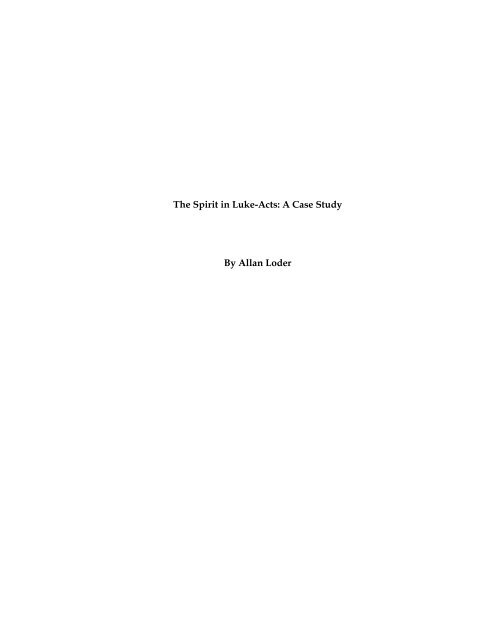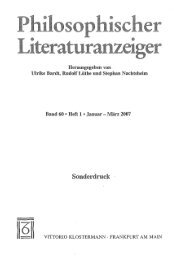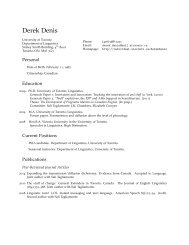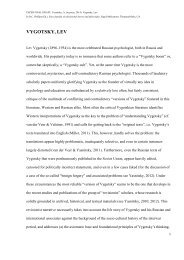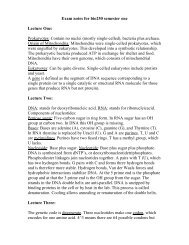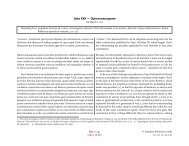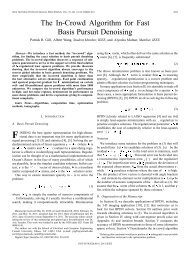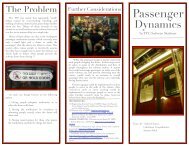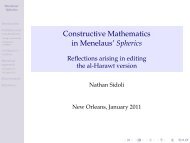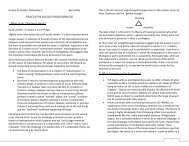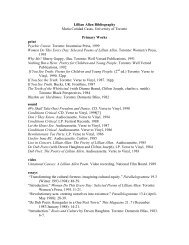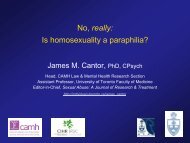When Hans von Baer wrote Der Heilige Geist in den Lukasschriften ...
When Hans von Baer wrote Der Heilige Geist in den Lukasschriften ...
When Hans von Baer wrote Der Heilige Geist in den Lukasschriften ...
Create successful ePaper yourself
Turn your PDF publications into a flip-book with our unique Google optimized e-Paper software.
The Spirit <strong>in</strong> Luke-Acts: A Case Study<br />
By Allan Loder
Introduction<br />
Dur<strong>in</strong>g the latter part of n<strong>in</strong>eteenth century and early twentieth century<br />
most discussions on the Spirit <strong>in</strong> the Third Gospel centered on i<strong>den</strong>tify<strong>in</strong>g<br />
Hellenistic cultic <strong>in</strong>fluences on Lucan Pneumatology. 1 Devotees of the<br />
Religionsgeschichtliche Schule [―school of the history of religion‖] sought to expla<strong>in</strong> an<br />
apparent difference between Luke‘s view of the Spirit as ‗the power of miracle and<br />
revelation‘ and Paul‘s concept of the Spirit as ‗the <strong>in</strong>ner pr<strong>in</strong>ciple of new-creation<br />
life‘ by suggest<strong>in</strong>g that each author developed a dist<strong>in</strong>ctive Pneumatology that was<br />
shaped by the traditions and religious experience of his respective community of<br />
faith. 2 It was thought that Paul—the first to describe the Spirit <strong>in</strong> terms of<br />
convey<strong>in</strong>g salvation—developed his Pneumatology as a result of observ<strong>in</strong>g the<br />
―effect‖ that the Spirit had on the lives of <strong>in</strong>dividual Christians. 3 Luke‘s<br />
Pneumatology was regarded as the primitive Church‘s understand<strong>in</strong>g of the Spirit<br />
that was based on a ―thoroughly Hellenistic encounter with πνεῦμα [pneuma =<br />
Spirit]‖ 4 Accord<strong>in</strong>gly, the majority of material <strong>in</strong> the Gospels perta<strong>in</strong><strong>in</strong>g to the<br />
Spirit would be Hellenistic <strong>in</strong> orig<strong>in</strong>, not Jewish. 5<br />
By the mid-1920s the Religionsgeschichtliche Schule‘s methods of <strong>in</strong>vestigation<br />
1 For example, B. Weiss, Lehrbuch der Biblischen Theologie des Neun Testaments, 2 nd ed. (Berl<strong>in</strong>:<br />
Hertz, 1873); O. Pfleidrer, <strong>Der</strong> Paul<strong>in</strong>ismus (Leipzig: H<strong>in</strong>richs, 1873).<br />
2 This was understood <strong>in</strong> the context of a view of early Church history that was based on<br />
Hegelian philosophy (i.e., thesis= Lucan Pneumatology; antithesis= Paul‘s Pneumatology).<br />
3 See Hermann Gunkel, Wirkungen des heiligen <strong>Geist</strong>es nach der populären Anschauung der<br />
apostolischen Zeit und der Lehre des Apostels Paulus, (Gött<strong>in</strong>gen: Van<strong>den</strong>hoeck & Ruprecht, 1888);<br />
English translation, The Influence of the Holy Spirit: The Popular View of the Apostolic Age and the<br />
Teach<strong>in</strong>g of the Apostle Paul, trans. Roy A. Harrisville and Philip A. Quanbeck (Philadelphia, PA:<br />
Fortress Press, 1979), 76.<br />
4 <strong>Hans</strong> Leisegang, <strong>Der</strong> Heilege <strong>Geist</strong>; Das Wesen und Wer<strong>den</strong> der Mystisch-Intuitiven Erkenntnis<br />
<strong>in</strong> der Philosophie und Religion der Griechen, (Unveränderter reprografischer Nachdruck der Ausg.<br />
Leipzig u. Berl<strong>in</strong> 1919, Repr<strong>in</strong>t, Stuttgart: Teubner, 1967), 4. cf. Pneuma Hagion: der Ursprung des<br />
<strong>Geist</strong>esbegrifts der Synoptischen Evangelien aus der griechischen mystik. Leipzig: H<strong>in</strong>richs, 1922.<br />
5 Laisegang develops this idea <strong>in</strong> his second work, Pneuma Hagion, which was a reaction to<br />
E. Nor<strong>den</strong> and A. Harnack who saw the gospel traditions as entirely Jewish <strong>in</strong> orig<strong>in</strong>. For more on<br />
this see Max Turner, Power from on High: The Spirit <strong>in</strong> Israel‘s Restoration and Witness <strong>in</strong> Luke-Acts. JPT<br />
Sup9. (Sheffield: Academic Press, 1996), 26-29.<br />
2
were deemed <strong>in</strong>adequate by those seek<strong>in</strong>g to understand Luke with<strong>in</strong> the context<br />
of his Jewish-Christian religious environment. Their po<strong>in</strong>t of contention was the<br />
religio-historical school‘s failure to take <strong>in</strong>to account the developments <strong>in</strong> Jewish<br />
thought dur<strong>in</strong>g the Second Temple period that most likely would have helped<br />
shape the Pneumatology of the early Church. In 1926 two books were published—<br />
Friedrich Büchsel‘s <strong>Der</strong> <strong>Geist</strong> Gottes im Neuen Testament 6 and <strong>Hans</strong> <strong>von</strong> <strong>Baer</strong>‘s <strong>Der</strong><br />
<strong>Heilige</strong> <strong>Geist</strong> <strong>in</strong> <strong>den</strong> <strong>Lukasschriften</strong> 7 —that challenged the Religionsgeschichtliche<br />
Schule‘s conclusions concern<strong>in</strong>g the nature of the gift of the Spirit <strong>in</strong> Luke-Acts.<br />
Büchsel and <strong>von</strong> <strong>Baer</strong> attempted to expla<strong>in</strong> the apparent difference between Luke‘s<br />
view of the Spirit as ‗the power of miracle and revelation‘ and Paul‘s concept of the<br />
Spirit as ‗the <strong>in</strong>ner pr<strong>in</strong>ciple of new-creation life‘ by suggest<strong>in</strong>g that Luke and Paul<br />
differed only <strong>in</strong> what they chose to emphasize about the Spirit‘s work. Both NT<br />
writers shared a common ―Jewish‖ Pneumatology that can only be understood<br />
aga<strong>in</strong>st the backdrop of Jewish expectations of the Spirit—particularly those based<br />
on Jewish <strong>in</strong>terpretations of relevant OT texts. Hence, any attempt to understand<br />
Luke‘s concept of the Spirit by exam<strong>in</strong><strong>in</strong>g possible <strong>in</strong>fluences from foreign (i.e.,<br />
Hellenistic) cults would be misdirected. 8<br />
Büchsel and <strong>von</strong> <strong>Baer</strong> essentially set the agenda for nearly all subsequent<br />
major scholarly <strong>in</strong>vestigations of Lucan Pneumatology. Although few have agreed<br />
fully with their conclusions, their methodology has been widely accepted.<br />
Consequently, nearly all scholarly discussions on the Spirit <strong>in</strong> Luke-Acts s<strong>in</strong>ce 1926<br />
approach the subject by exam<strong>in</strong><strong>in</strong>g the Jewish traditions and sources that would<br />
have <strong>in</strong>formed Luke‘s concept of the Spirit.<br />
Büchsel‘s and <strong>von</strong> <strong>Baer</strong>‘s contributions also raised a fundamental question<br />
concern<strong>in</strong>g Lucan Pneumatology that cont<strong>in</strong>ues to be the subject of considerable<br />
scholarly debate. Does Luke view the Spirit essentially as the Spirit of ‗new-<br />
6 Gütersloh: Bertelsmann, 1926.<br />
7 Stuttgart: Kohlhammer, 1926.<br />
8 <strong>von</strong> <strong>Baer</strong>, <strong>Der</strong> <strong>Heilige</strong> <strong>Geist</strong>, 4.<br />
3
creation life‘ (i.e., conversion-<strong>in</strong>itiation, ethical renewal, etc.), or essentially as an<br />
empower<strong>in</strong>g for mission, or both?<br />
A survey of published materials from all sides of the debate shows that a<br />
key passage for understand<strong>in</strong>g the nature of the gift of the Spirit <strong>in</strong> Luke-Acts is<br />
Luke‘s account of Jesus‘ experience of the Spirit at Jordan (Luke 3:21-22). James D.<br />
G. Dunn 9 believes that this passage is about Jesus‘ <strong>in</strong>itiation <strong>in</strong>to ‗new covenant<br />
life‘ and ‗sonship‘—which Dunn sees as paradigmatic for the Disciples‘<br />
conversion-<strong>in</strong>itiation <strong>in</strong>to the Christian faith. The OT background for Luke, says<br />
Dunn, is the Jewish expectation of the Spirit based on <strong>in</strong>terpretations of Ezekiel 36.<br />
The major weakness with this view, however, is that Luke neither quotes nor<br />
alludes to Ezekiel 36. 10 Conversely, Robert Menzies 11 and Roger Stronstad 12 see<br />
Jesus‘ Jordan experience as a Messianic ano<strong>in</strong>t<strong>in</strong>g with power for mission—which<br />
they view as paradigmatic for the Disciples‘ experience of the Spirit as an<br />
empower<strong>in</strong>g for mission (e.g., Acts 2). They cite Luke‘s use of Isaiah 61 (Luke 4:18-<br />
19) and LXX Joel 3:1-5 ([MT Joel 2:28-32] Acts 2:17-21) as evi<strong>den</strong>ce that the Spirit for<br />
Luke is the ‗Spirit of Prophecy‘ referred to <strong>in</strong> early Jewish writ<strong>in</strong>gs. However,<br />
Menzies and Stronstad fail to expla<strong>in</strong> Luke‘s statements perta<strong>in</strong><strong>in</strong>g to the effect of<br />
the Spirit on the life of the Christian community itself (Acts 5:1-11; 6:3-5; 11:24;<br />
13:52), as well as Luke‘s concern that all believers should receive the gift of the<br />
Spirit. Therefore, a solution is needed that does justice to both aspects of Lucan<br />
Pneumatology—i.e., the Spirit as the source of ‗new-creation life‘ and as an<br />
empower<strong>in</strong>g for mission.<br />
The purpose of this paper is to exam<strong>in</strong>e Luke‘s account of Jesus‘ ―sermon‖<br />
<strong>in</strong> the synagogue at Nazareth (Luke 4:16-30)—which seems to be a Lucan<br />
explanation of Jesus‘ experience of the Spirit at Jordan—<strong>in</strong> order to determ<strong>in</strong>e what<br />
9 Baptism <strong>in</strong> the Holy Spirit: A Re-exam<strong>in</strong>ation of the New Testament Teach<strong>in</strong>g on the Gift of the<br />
Spirit <strong>in</strong> Relation to Pentecostalism Today. Naperville, Ill<strong>in</strong>ois: Alec R. Allenson, 1970.<br />
10 Surpris<strong>in</strong>gly, Dunn ignores Luke‘s use of Isa 61 and LXX Joel 3.<br />
11 Empowered for Witness: The Spirit <strong>in</strong> Luke-Acts. Sheffeld: JSOT Press, 1994.<br />
12 The Charismatic Theology of Sa<strong>in</strong>t Luke. Peabody, MA: Hendrickson, 1984.<br />
4
this passage reveals about the essential nature of the gift of the Spirit <strong>in</strong> Luke-Acts.<br />
That Luke <strong>in</strong>tentionally makes a connection between the baptism narrative and the<br />
Nazareth pericope is evi<strong>den</strong>t from his redactional references to the Spirit <strong>in</strong> 4:1<br />
(πλήρης πνεύματος ἁγίου�[plērēs pneumatos agiou = ―full of the Holy Spirit‖) and<br />
4:14 (ἐν τῇ δυνάμει τοῦ πνεύματος [en tē dunamei tou pneumatos = ―<strong>in</strong> the power of<br />
the Spirit‖]). 13 Furthermore, Luke‘s departure from the regular sequence of events<br />
<strong>in</strong> the gospel tradition (cf. Mark 6:1-6; Matt 13:53-58), 14 along with the addition of<br />
Jesus‘ claim to fulfill Isa 61:1-2, suggests that this pericope serves a special<br />
―programmatic‖ function <strong>in</strong> Luke-Acts. 15<br />
Luke 4:16-30: Luke’s Source(s) and the Redaction of Isa 61:1-2 (58:6d)<br />
So far, no consensus has been reached among scholars concern<strong>in</strong>g how<br />
much of Luke‘s Nazareth pericope is directly depen<strong>den</strong>t on his source(s) and how<br />
much of it is a Lucan construction. 16 Yet there is little doubt that Luke used a<br />
source or sources besides Mark and ―Q‖ when he composed his account of Jesus‘<br />
―sermon‖ <strong>in</strong> the synagogue at Nazareth. 17<br />
Accord<strong>in</strong>g to Luke, Jesus beg<strong>in</strong>s his public m<strong>in</strong>istry <strong>in</strong> the same town where<br />
he grew up (4:16). He is handed a scroll of the prophet Isaiah and reads from it<br />
what seems to be Isa 61:1-2. However, what Jesus actually ―reads‖ is a conflation<br />
of Isa 61:1a, b, d; 58:6d and 61:2a. Two phrases are omitted from the Isaianic text<br />
13 For more on this, as well as the ‗programmatic‘ significance of the Nazareth pericope see<br />
Jack T. Sanders, The Jews <strong>in</strong> Luke-Acts (London: SCM Press, 1987), 65-72.<br />
14 Although apparently aware of Jesus‘ earlier m<strong>in</strong>istry <strong>in</strong> Capernaum (cf. 4:23), Luke makes<br />
this the first event <strong>in</strong> Jesus‘ public m<strong>in</strong>istry.<br />
15 For more on this see Joseph Fitzmyer, The Gospel Accord<strong>in</strong>g to Luke: I-IX, The Anchor Bible<br />
Commentary, vol. 28 (Gar<strong>den</strong> City, NY: Doubleday, 1985), 529; R. L. Brawley, Luke-Acts and the Jews:<br />
Conflict, Apology and Conciliation (Atlanta, GA: John Knox, 1987), ch. 2 passim; H. J. Cadbury, The<br />
Mak<strong>in</strong>g of Luke-Acts (London: SPCK Press, 1968), 187-189.<br />
16 For more on this see J. Fitzmyer, The Gospel Accord<strong>in</strong>g to Luke I-IX, 526-528; Nolland, Word<br />
Biblical Commentary, vol. 35a, 273-274.<br />
17 Contra E. Haenchen who sees no evi<strong>den</strong>ce of any source besides Mark. See ―Historie und<br />
Verkündigung bei Markus und Lukas.‖ In Das Lukas-Evangelium, ed. Georg Braumann (Darmstadt:<br />
Wissenschaftliche Buchgesellschaft, 1974), 287–316.<br />
5
cited <strong>in</strong> Luke chapter four: Isa 61:1c (―to heal the broken-hearted‖ 18 ) and Isa 61:2b<br />
(―the day of recompense‖ LXX ἡμέραν ἀνταποδόσεως [hēmeran antapodoseōs],<br />
or�―the day of vengeance of our God‖ MT וניהלאל םקנ<br />
םוי [yom naqam l‘eloh<strong>in</strong>u]). A<br />
phrase from Isa 58:6, (―to set free those who are oppressed‖ τεθραυσμένους ἐν<br />
ἀφέσει [tethrausmenous en aphesei]) is <strong>in</strong>serted at the end of v. 18. Otherwise, the<br />
citation of Isaiah is essentially <strong>in</strong> verbal agreement with the text of LXX 19 —except<br />
for the change from καλέσαι (kalesai = ―to call out, call for‖) <strong>in</strong> 61:2a to κηρύξαι<br />
(keruxai = ―to proclaim, preach‖) <strong>in</strong> v.19a.<br />
It has been suggested that Luke‘s conflated text is due to a ―slip of memory‖<br />
on his part as he attempted to cite Isa 61:1-2 without the aid of a written copy <strong>in</strong><br />
front of him. 20 However, this is improbable for the follow<strong>in</strong>g reasons: (1) Given<br />
that heal<strong>in</strong>g occupies much of Luke‘s attention <strong>in</strong> the pericopae that follow (e.g.,<br />
4:23-27; 38-40; 5:12-26), it is unlikely that he would have ―forgotten‖ the reference<br />
to heal<strong>in</strong>g <strong>in</strong> Isa 61. It is ―difficult to see why an author who <strong>in</strong>troduces<br />
Septuag<strong>in</strong>tal diction <strong>in</strong>to a narrative would then depart from the text of the LXX<br />
when he comes to the words which are at the heart of the story;‖ 21 (2) The phrase<br />
εὗρεν τὸν τόπον οὗ ἦν γεγραμμένον [euren ton topon ou en gegraphemmenon = ―he<br />
found the place where it was written‖] <strong>in</strong> v.17 suggests that Luke had a specific<br />
passage <strong>in</strong> m<strong>in</strong>d that would ensure the validity of Jesus m<strong>in</strong>istry as the fulfillment<br />
of OT prophecy; (3) As Adolf Schlatter po<strong>in</strong>ts out, the syntax result<strong>in</strong>g from the<br />
18 A ����0102 f1 Φ f vgcl syp.h bomss ; irlat has ἰάσασθαι τοὺς συντετριμμένους τῇ καρδίᾳ [iasasthai<br />
tous suntetrimmenous tē kardia = ―to b<strong>in</strong>d up the brokenhearted‖]. It does not appear <strong>in</strong> א B D L W<br />
��f1 33 579 700 892 pc lat sys co; or Eus Did. Given the importance and wide geographical<br />
distribution of those witnesses <strong>in</strong> favour of the absence of this phrase, it was probably added to the<br />
textual tradition—perhaps <strong>in</strong> an attempt to harmonize Luke 4:18-19 and Isa 61:1-2.�<br />
19 i.e., aga<strong>in</strong>st the Hebrew MT. e.g., κυρίου (kuriou =―Lord‖) <strong>in</strong>stead of הוהי ינדא (Adonai<br />
YHWH = ―of the Lord Yahweh‖), and τυφλοῖς���tuphlois = ―bl<strong>in</strong>d‖) <strong>in</strong>stead of םירוסאלו (ve·la·'a·su·rim<br />
= ―to those bound,‖ ―prisoners‖).<br />
20 Alfred Plummer, A Critical and Exegetical Commentary on the Gospel Accord<strong>in</strong>g to S. Luke,<br />
ICC 4th ed. (Ed<strong>in</strong>burgh: T & T Clark, 1901), 121.<br />
21 Bruce Chilton, ―Announcement <strong>in</strong> Nazara: An Analysis of Luke 4:16-21,‖ In Gospel<br />
Perspectives: Studies of History and Tradition <strong>in</strong> the Four Gospels, vol. 2. ed. R. T. France and David<br />
Wenham (Sheffield: JSOT Press, 1981), 164.<br />
6
position of� ἐν [en = ―<strong>in</strong>‖] <strong>in</strong> the <strong>in</strong>serted phrase <strong>in</strong> v. 18 is uncharacteristic of<br />
Luke‘s literary style; 22 (4) The Aramaic form Ναζαρά [Nazara] <strong>in</strong> 4:16 reflects a<br />
traditional source—probably Palest<strong>in</strong>ian <strong>in</strong> orig<strong>in</strong>. 23 Luke consistently uses the<br />
form Ναζαρὲθ [Nazareth] elsewhere; and (5) The embedd<strong>in</strong>g of one OT quotation<br />
with<strong>in</strong> another is found nowhere else <strong>in</strong> the NT, and such embedded citations are<br />
rare <strong>in</strong> Judaism. 24 This unusual feature suggests that the version of the Isaianic text<br />
<strong>in</strong> Luke 4:18 must have come from one of the Evangelist‘s dist<strong>in</strong>ctive sources—i.e.,<br />
not shared by the other Gospel writers. 25 Therefore, ―one can say not only<br />
probably but with a degree of certa<strong>in</strong>ty that this passage is a product of neither<br />
Luke‘s memory nor of his theology, but the voice of his tradition.‖ 26<br />
Intertextual Signifiers: The Citation of Isa 61:1-2 (58:6d) <strong>in</strong> Its Lucan Context<br />
While extensive literary-critical analyses of Luke 4:16-30 is outside the scope<br />
of this study, some of the methodology is used <strong>in</strong> the present <strong>in</strong>vestigation to<br />
determ<strong>in</strong>e what evi<strong>den</strong>ce there is for a ‗l<strong>in</strong>k‘ between the Third Gospel and some of<br />
the Jewish writ<strong>in</strong>gs composed dur<strong>in</strong>g the Second Temple period. The term ‗l<strong>in</strong>k‘<br />
does not imply that Luke was depen<strong>den</strong>t on those texts for literary source material.<br />
Rather, <strong>in</strong> the context of this study two or more texts are said to be ‗l<strong>in</strong>ked‘ when<br />
22 ―Anti-Judaism and New Testament Scholarship,‖ In Joseph B. Tyson, Luke, Judaism, and<br />
the Scholars: Critical Approaches to Luke-Acts (Columbia: University of South Carol<strong>in</strong>a Press, 1999),<br />
226-227.<br />
23 J. Fitzmyer suggests that Ναζαρά [Nazara] reflects a more ancient Semitic form of the<br />
name, Anchor Bible Commentary, vol. 28, 530. See also C. J. Schreck, ‗The Nazareth Pericope: Luke<br />
4.16-30 <strong>in</strong> Recent study,‖ <strong>in</strong> The Gospel of Luke, ed. F. Neirynck (Leuven: University Press, 1989), 399-<br />
471.<br />
24 Max Turner, Power From On High: The Spirit <strong>in</strong> Israel‘s Restoration and Witness <strong>in</strong> Luke-Acts.<br />
JPT Sup 9 (Sheffeld: Academic Press, 1996), 216.<br />
25 For more on this see G. N. Stanton, ―On the Christology of Q,‖ In Christ and Spirit <strong>in</strong> the<br />
New Testament, ed. Barnabas L<strong>in</strong>dars and Stephen S. Smalley (Cambridge: University Press, 1973),<br />
33-34. The hypothesis that Luke himself added Isa 58:6d to Isa 61:1-2 <strong>in</strong> order to make the<br />
connection between Jesus‘ preach<strong>in</strong>g and the ―forgiveness of s<strong>in</strong>s‖ cannot be susta<strong>in</strong>ed. See Turner,<br />
Power From On High, 222-223.<br />
26 Chilton, ―Announcement <strong>in</strong> Nazara,‖ 164.<br />
7
they share a common <strong>in</strong>terpretative tradition. 27 It is assumed that most scripture is<br />
―used by <strong>in</strong>dividuals and their communities as mediated to them by their<br />
contemporaries and immediate forebears.‖ 28 The Lucan community would have<br />
<strong>in</strong>herited certa<strong>in</strong> exegetical traditions associated with a number of OT texts. The<br />
aim here is to i<strong>den</strong>tify <strong>in</strong>tertextual signifiers 29 <strong>in</strong> Luke 4:16-30 and its near context<br />
that <strong>in</strong>dicate Luke‘s use of these <strong>in</strong>terpretative traditions <strong>in</strong> the writ<strong>in</strong>g of his<br />
Gospel.<br />
Luke explicitly states that his purpose for writ<strong>in</strong>g is to offer an ―orderly<br />
account‖ (διήγησις�[diēgēsis]) of what was already known by his <strong>in</strong>tended<br />
audience, <strong>in</strong> order to verify the faithfulness of the testimony given <strong>in</strong> the tradition<br />
handed down to them (cf. Luke 1:1-4). S<strong>in</strong>ce the Evangelist‘s first readers were<br />
familiar with much of the material presented, it stands to reason that the Third<br />
Gospel reflects a pre-Lucan tradition.<br />
Although there is no known example <strong>in</strong> Jewish writ<strong>in</strong>gs where Isa 61:1-2<br />
and 58:6d are brought together, there are <strong>in</strong>stances where Isa 61 is related to other<br />
texts perta<strong>in</strong><strong>in</strong>g to Jubilee ‗release‘ (Lev 25; Deut 15). 30 With<strong>in</strong> the Qumran corpus,<br />
27 The term used <strong>in</strong> the field of literary theory to signify such a relationship among texts is<br />
‗<strong>in</strong>tertextuality.‘ It was first applied to literary theory by Julia Kristeva <strong>in</strong> her essay "Word,<br />
Dialogue and Novel," first published <strong>in</strong> French <strong>in</strong> Séméiotiké: recherches pour une sémanalyse (Paris:<br />
Seuil, 1969) and available <strong>in</strong> English <strong>in</strong> The Kristeva Reader ed. Toril Moi (Oxford: Basil Blackwell,<br />
1986) 35-61. For more on ‗<strong>in</strong>tertextuality‘ see Michael Worton and Judith Still, eds, Intertextuality:<br />
Theories and Practices (Manchester: University Press, 1990). With respect to Jewish exegetical<br />
traditions, see Sipke Draisma, ed. Intertextuality <strong>in</strong> Biblical Writ<strong>in</strong>gs; essays <strong>in</strong> Honour of Bas van Israel.<br />
Kampen: Uitgeversmaatschappij J. H. Kok, 1989.<br />
28 George J. Brooke, Shared Intertextual Interpretations <strong>in</strong> the Dead Sea Scrolls and the New<br />
Testament (Orion Center for the Study of the Dead Sea Scrolls and Associated Literature , Hebrew<br />
University, 1996), 1<br />
29 The term signifier is used <strong>in</strong> the field of literary theory to refer to any l<strong>in</strong>guistic form that<br />
is used by an author to construct and/or convey mean<strong>in</strong>g. A group of signifiers constitutes a signsystem.<br />
In <strong>in</strong>tertextuality theory, the method of determ<strong>in</strong><strong>in</strong>g mean<strong>in</strong>g from a text is to take a work<br />
of literature and evaluate that text by other texts. As one (or several) sign-system(s) is transposed<br />
from one ‗sett<strong>in</strong>g‘ <strong>in</strong>to another, it is believed that some of its ‗mean<strong>in</strong>g‘ is carried with it—even<br />
though the author of text <strong>in</strong> question may ‗transform‘ older signifiers <strong>in</strong>to someth<strong>in</strong>g new. See<br />
Kristeva, The Kristeva Reader, 102-111. cf. Revolution <strong>in</strong> Poetic Language, trans. Margaret Waller (New<br />
York: Columbia University Press, 1984), 59-60.<br />
30 For more on Isa 61 <strong>in</strong> Judaism see J. A. Sanders, ‗From Isa 61 to Luke 4,‖ <strong>in</strong> Christianity,<br />
Judaism and Other Greco-Roman Cults, ed. Jacob Neusner (Lei<strong>den</strong>: Brill, 1975), 75-106.<br />
8
one document that stands out as hav<strong>in</strong>g parallels to Luke 4 is 11Q13<br />
(11QMelchizedek). This is a pesher-exegesis with references to Lev 25:9, 13, Deut<br />
15:2, Ps 82:1-2; Ps 7:8-9, Dan 9:26, Isa 52:7 and Isa 61:1-3. In 11Q13 the text of Isa<br />
61:1-3 serves as the ―organiz<strong>in</strong>g framework‖ for the author‘s discussion concern<strong>in</strong>g<br />
a com<strong>in</strong>g messianic eschatological Jubilee. 31 Accord<strong>in</strong>g to 11Q13, Israel‘s ultimate<br />
Jubilee is to be <strong>in</strong>augurated by an exalted figure (Melchizedek?) who arrives at the<br />
end of the tenth Jubilee period (l<strong>in</strong>es 7-9) to ―proclaim liberty‖ (l<strong>in</strong>es 4-6), and to<br />
release the captives from the power of Belial (l<strong>in</strong>es 15, 25). This exalted figure is<br />
―the ano<strong>in</strong>ted of the Spirit‖ who will both announce and br<strong>in</strong>g salvation to Zion<br />
(l<strong>in</strong>es 18-19).<br />
A survey of Jewish literature from the Second Temple period shows that<br />
there was a dist<strong>in</strong>ct tradition <strong>in</strong> Judaism of us<strong>in</strong>g the language of Jubilee release to<br />
depict salvation (cf. Pss. Sol. 11; Shemeneh ‗Esreh 10; Jubilees 23:11-32). 32 That Jubilee<br />
imagery is be<strong>in</strong>g picked up by Luke is signified <strong>in</strong> part by the word ἄφεσις<br />
[aphesis] <strong>in</strong> the phrase <strong>in</strong>serted from Isa 58:6—which seems to have a different<br />
sense <strong>in</strong> Luke 4:18 than elsewhere <strong>in</strong> Luke-Acts. 33 The ord<strong>in</strong>ary mean<strong>in</strong>g of ἄφεσις<br />
[aphesis] <strong>in</strong> Greek is ―release,‖ ―liberty,‖ ―freedom,‖ et cetera. 34 <strong>When</strong> a different<br />
mean<strong>in</strong>g is <strong>in</strong>tended, some <strong>in</strong>dication is usually given by the author. In Luke-Acts<br />
31 Turner, Power From On High, 226.<br />
32 This tradition goes back at least to the time of Deutero-Isaiah. It is already evi<strong>den</strong>t <strong>in</strong> Isa<br />
61:1-2 (cf. Lev 25; Deut 15). See John D. W. Watts , Isaiah 34–66. Word Biblical Commentary, vol.25.<br />
eds. David A. Hubbard and Glenn W. Barker (Dallas, TX: Word Books, 1987), 299-305; M. Miller,<br />
―The Function of Isa. 61:1–2 <strong>in</strong> 11Q Melchizedek,‖ JBL 88 (1969): 467–469.<br />
33 Contra Robert Menzies who proposes that Luke would have read the word ���������<strong>in</strong><br />
Isa 58:6d to mean ―forgiveness of s<strong>in</strong>s,‖ <strong>in</strong> keep<strong>in</strong>g with the regular mean<strong>in</strong>g of the term <strong>in</strong> Luke-<br />
Acts. See The Development of Early Christian Pneumatology With Special Reference to Luke-Acts<br />
(Sheffeld: JSOT Press, 1991), 171-173. cf. C. M. Tucket, ―Luke 4,16-30, Isaiah and Q,‖ <strong>in</strong> Joël Delobel,<br />
ed. Logia: Les paroles de Jesus—The Say<strong>in</strong>gs of Jésus (Leuven: Uitgeverij Peeters, 1982), 248. For more<br />
on why this hypothesis cannot be susta<strong>in</strong>ed see Turner, Power From on High, 222-226.<br />
34 In 40 of the 45 occurrences of ἄφεσις [aphesis] <strong>in</strong> LXX the reference is to literal release<br />
from debt or oppression of some k<strong>in</strong>d. The exceptions are Exo 18:2 (Moses ‗released‘ Zipporah <strong>in</strong>to<br />
her father‘s care); 23:11 (laws that fields should be left unfarmed [i.e., ‗released‘ from be<strong>in</strong>g<br />
farmed]); Lev 16:26 (the Scapegoat ‗released‘ <strong>in</strong>to the wilderness); Eze 47:3 (water ‗released‘ [i.e.,<br />
flow<strong>in</strong>g out] from the temple) and Judith 11:14 (‗permission‘ granted by elders). There is no<br />
example <strong>in</strong> LXX where ἄφεσις [aphesis] refers to ‗forgiveness‘ of s<strong>in</strong>s.<br />
9
ἄφεσις [aphesis] is nearly always used <strong>in</strong> the sense of ―forgiveness,‖ and Luke<br />
<strong>in</strong>dicates this by collocat<strong>in</strong>g ἄφεσις [aphesis] and ἁμαρτιῶν [hamartiōn = ―of s<strong>in</strong>s‖]<br />
(cf. Luke 1:77; 3:3; 24:47; Acts 2:38; 5:31; 10:43; 13:38; 26:18). The one exception is <strong>in</strong><br />
Luke 4:18—which is clearly part of the Evangelist‘s source material and not a<br />
Lucan composition—where ἄφεσις [aphesis] is collocated with αἰχμαλώτοις<br />
(aichmalotios = ―captives‖). Hence, the k<strong>in</strong>d of ‗release‘ depicted <strong>in</strong> Luke 4 seems to<br />
be the same as that envisaged <strong>in</strong> Isaiah.<br />
Luke‘s use of Jubilee imagery is also signified by the content of the<br />
genealogy <strong>in</strong> Luke 3:23-38—which serves to prepare the reader for <strong>in</strong>terpret<strong>in</strong>g the<br />
account of Jesus‘ ―read<strong>in</strong>g‖ of Isa 61:1-2 (58:6d) <strong>in</strong> terms of Jubilee. Luke places the<br />
genealogy of Jesus between the Baptism account (3:21-22) and the Temptation<br />
narrative (4:1-13). This is followed by a summary statement concern<strong>in</strong>g the<br />
beg<strong>in</strong>n<strong>in</strong>g of Jesus‘ Galilean m<strong>in</strong>istry (4:14-15), and the Nazareth pericope (4:16-30).<br />
Luke‘s version of Jesus‘ genealogy is especially relevant to the debate that follows<br />
Jesus‘ ―read<strong>in</strong>g‖ and <strong>in</strong>terpretation of Isa 61:1-2 (58:6d). The crowd‘s refusal to<br />
hear the message announced to them is <strong>in</strong>dicated by their (rhetorical?) question,<br />
―Isn‘t this Joseph‘s son?‖ (4:22). 35 ―But the reader who has followed Jesus through<br />
his virg<strong>in</strong>al conception and childhood, ano<strong>in</strong>t<strong>in</strong>g <strong>in</strong> baptism, and test<strong>in</strong>g by the<br />
devil knows that this ‗son of Joseph‘ is truly the ‗son of God‘ (cf. 2:48-50),<br />
appo<strong>in</strong>ted to <strong>in</strong>augurate God‘s reign.‖ 36<br />
From the reader‘s perspective, the question about Jesus‘ ancestry<br />
immediately draws attention to the genealogy <strong>in</strong> Luke 3:23-38. Unlike Matthew,<br />
who is concerned primarily with Jewish orig<strong>in</strong>, Luke traces Jesus‘ genealogy all the<br />
way back to Adam, ―[the son] of God‖(τοῦ θεοῦ�[tou theou]). Luke‘s division of<br />
world history <strong>in</strong>to seventy-seven generations is significant because it reflects a<br />
chronological scheme found <strong>in</strong> some ‗Intertestamental‘ Jewish apocalyptic<br />
35 Contra Fitzmyer, who sees the query as an expression of ―pleasant surprise or<br />
admiration.‖ (The Gospel Accord<strong>in</strong>g to Luke I-IX, 353).<br />
36 David Tiede, Prophecy and History <strong>in</strong> Luke-Acts (Philadelphia, PA: Fortress Press, 1980), 38.<br />
10
writ<strong>in</strong>gs, such as 4Q202 (4QEnoch b , Col. IV = Ethiopian 1 Enoch 10:8-12). In 4Q202<br />
the heavenly figure Michael 37 is told to b<strong>in</strong>d the Watchers for ―seventy ge[nerations<br />
<strong>in</strong> the valleys of] the earth until the great day [of their judgment].‖ 38 In the Lucan<br />
genealogy Enoch is the representative of the seventh generation from Adam—<br />
which is a common Jewish tradition (cf. Gen 5; 1 Chr 1:1-3; Jude 14). By plac<strong>in</strong>g<br />
Jesus <strong>in</strong> the seventieth generation after Enoch, Luke has a total of seventy-seven<br />
generations lead<strong>in</strong>g up to the time of Christ. ―For a m<strong>in</strong>d concerned with the<br />
symbolic significance of sevens special significance also attaches to seven times<br />
seven—the jubilee figure of forty-n<strong>in</strong>e. It cannot be acci<strong>den</strong>tal that <strong>in</strong> the Lukan<br />
genealogy the name Jesus occurs not only <strong>in</strong> seventy-seventh place, but also <strong>in</strong><br />
forty-n<strong>in</strong>th place—where the only namesake of Jesus among his ancestors appears<br />
(Luke 3:29).‖ 39 While it cannot be proven that Luke (or the composer of his source<br />
material) knew 1 Enoch, or that Jubilee chronology was common to Judaism <strong>in</strong><br />
general, at the very least it can be said that there is someth<strong>in</strong>g ―Enochic‖ beh<strong>in</strong>d the<br />
composition of the Lucan genealogy. 40 In 4Q202 the great Day of Judgment comes<br />
at the end of seventy generations (i.e., ten periods of seven generations each). In<br />
11QMelchizedek the Day of Atonement comes at the end of the tenth jubilee period<br />
(cf. l<strong>in</strong>es 7-9). In the Third Gospel ―the year of the Lord‘s favour‖ is <strong>in</strong>augurated<br />
by Jesus, who is the representative of the seventy-seventh generation. A common<br />
theme <strong>in</strong> 4Q202 (=Ethiopian 1 Enoch), 11QMelchizedek and Luke is that an<br />
37It is widely agreed that the names ―Michael‖ and ―Melchizedek‖ often refer to the same<br />
eschatological figure <strong>in</strong> apocalyptic literature. See A. S. Van der Woude, "Melchisedek als<br />
Himmlische Erlosergestalt <strong>in</strong> <strong>den</strong> Neugefun<strong>den</strong>en Eschatalogischen Midraschim aus Qumran<br />
Hohle XI" (Melchizedek as Heavenly Savior Figure <strong>in</strong> the Newly Found Eschatological Midrash<br />
From Qumran Cave 11) Oudtestamentische Studien 14 (1965): 354-373; James R. Davila, ―Melchizedek,<br />
Michael, and War <strong>in</strong> Heaven,‖ SBL 1996 Sem<strong>in</strong>ar Papers (Atlanta, GA: Scholars Press, 1996): 259-72;<br />
Gareth Lee Cockerill, "Melchizedek or K<strong>in</strong>g of Righteousness," EQ 63 (1991): 305-312; Joseph A.<br />
Fitzmyer, "Now This Melchizedek..." (Heb 7:1)," CBQ 25 (1963): 305-321; "Further Light on<br />
Melchizedek from Qumran Cave 11," JBL 86 (1967): 25-41.<br />
38 Florent<strong>in</strong>o García Martínez and Eibert J. C. Tigchelaar, eds. The Dead Sea Scrolls: Study<br />
Edition (New York: Brill, 1999), 407.<br />
39 Richard Bauckham, Jude and the Relatives of Jesus <strong>in</strong> the Early Church (Ed<strong>in</strong>burgh: T. & T.<br />
Clark, 1990), 319.<br />
40 For more on this see Bauckham, Jude and the Relatives, 315-373.<br />
11
―ano<strong>in</strong>ted‖ eschatological figure arrives at the end of world history to free people<br />
from the power of evil (Belial, Watchers, Satan/evil spirits. cf. Luke 4:31-37; 4Q201<br />
Col. I, 15-16 = Ethiopian 1 Enoch 1:9-12; 41 11QMelchizedek Col. II, l<strong>in</strong>es 13-25). It<br />
seems that the best explanation for these thematic and schematic parallels is that all<br />
three authors shared a similar <strong>in</strong>terpretative tradition.<br />
Accord<strong>in</strong>g to Luke 4:21, when Jesus had f<strong>in</strong>ished ―read<strong>in</strong>g‖ Isa 61:1-2 (58:6d)<br />
he proclaimed to the crowd, ―Today this scripture has been fulfilled <strong>in</strong> your<br />
hear<strong>in</strong>g.‖ In the orig<strong>in</strong>al context of Isa 61:1-2, the one speak<strong>in</strong>g is the prophet<br />
(Isaiah?). Yet, Jesus cites this text as a prophecy about himself. He was not the first<br />
to <strong>in</strong>terpret such OT texts eschatologically or messianically, for this type of pesher-<br />
exegesis was common <strong>in</strong> Second Temple Judaism—at least at Qumran (cf. 11Q13,<br />
4Q521, 11Q19, 4Q174, 4Q385, 4Q500).<br />
The only other time that Luke alludes to Isa 61:1-2 is <strong>in</strong> chapter 7, where<br />
there is a question concern<strong>in</strong>g Jesus‘ messianic i<strong>den</strong>tity. In Luke 7:18-23 the story is<br />
told about some disciples of John the Baptist who were sent by their master to<br />
<strong>in</strong>quire whether Jesus is the ―com<strong>in</strong>g one‖ or if they should ―look for<br />
another‖(7:18-20). Jesus responds to their question by list<strong>in</strong>g six ‗signs‘ that<br />
confirm his i<strong>den</strong>tity:<br />
(1) ―the bl<strong>in</strong>d receive sight‖ τυφλοῖς ἀνάβλεψιν [tuphlois abableps<strong>in</strong>] �� ), (2) ―the<br />
lame walk,‖ (3) ―the lepers are cleansed,‖ (4) ―the deaf hear,‖ (5) ―the dead are<br />
raised,‖ and (6) ―the poor have good news preached to them‖ (7:22). Apparently,<br />
no other explanation was needed because Jesus was do<strong>in</strong>g the very th<strong>in</strong>gs expected<br />
of the Messiah (cf. 7:21). This list of ‗signs‘ for recogniz<strong>in</strong>g the Messiah—which<br />
of Spirits.‖<br />
41 In Ethopian 1 Enoch 48:10, this eschatological figure is callad the ―Ano<strong>in</strong>ted‖ of the ―Lord<br />
42 This seems to be a reference to LXX Isa 61:1. There is no counterpart to τυφλοῖς<br />
ἀνάβλεψιν [tuphlois abableps<strong>in</strong>] <strong>in</strong> the MT (i.e. Hebrew Bible), the Qumran MSS of Isaiah, or the<br />
Targum of Isaiah.<br />
12
was part of the Q source of the Gospels (cf. Matt 11:5//Luke 7:22)—seems to belong<br />
to a very early tradition shared by the followers of John the Baptist and the<br />
Christian community. 43<br />
A document from Qumran that is particularly helpful for understand<strong>in</strong>g<br />
some of the <strong>in</strong>terpretative tradition(s) beh<strong>in</strong>d Luke‘s Gospel is 4Q521 (4QMessianic<br />
Apocalypse). In 4Q521 (Frags. 2 col. II, l<strong>in</strong>es 8 and 12-13) there are two lists of<br />
‗signs of the Messiah‘ that comb<strong>in</strong>e elements from Isa 61:1, Deut 32:39, Ps 146:7-8,<br />
and Isa 35:5. 44 That these ‗lists‘ are similar to the one <strong>in</strong> Luke 7:22 is immediately<br />
apparent. But what is especially significant about 4Q521 is that it conta<strong>in</strong>s a<br />
statement about ‗rais<strong>in</strong>g the dead‘ as one of the expectations of the messianic age.<br />
It reads, ―[for] he will heal the badly wounded and will make the dead live, he will<br />
proclaim good news to the poor‖ רשבי םיונע היחי םיתמו םיללח אפרי ]יכ[<br />
(Frags. 2, col. II,<br />
l<strong>in</strong>e 12). The last phrase is a quote from Isa 61:1, but there is noth<strong>in</strong>g <strong>in</strong> the Hebrew<br />
Bible about a messianic figure rais<strong>in</strong>g the dead. Actually, 4Q521 is the only known<br />
example besides Q (= Luke 7:22//Matt 11:5) where ‗rais<strong>in</strong>g of the dead‘ is said to be<br />
a ‗sign‘ of the Messiah. 45 ―Through this Dead Sea Scroll fragment, coupled with the<br />
early Q source of the Gospels, we are taken back to a very early common tradition<br />
with<strong>in</strong> Palest<strong>in</strong>ian Judaism regard<strong>in</strong>g the ‗signs of the Messiah.‘‖ 46<br />
A comparative analysis of portions of Luke and certa<strong>in</strong> documents from<br />
Qumran reveals that there is a def<strong>in</strong>ite a ‗l<strong>in</strong>k‘ between the Third Gospel and some<br />
of the Jewish writ<strong>in</strong>gs composed dur<strong>in</strong>g the Second Temple period. Of course, care<br />
should be taken not to m<strong>in</strong>imize the fundamental differences between the religious<br />
43 See Fitzmeyer, The Gospel Accord<strong>in</strong>g to Luke I-IX, 662-665.<br />
44 The first item <strong>in</strong> l<strong>in</strong>e 12 (םיללח אפרי ―heal the wounded‖) seems to echo Isa 61:1. But it is<br />
the form probably found <strong>in</strong> the Vorlage of LXX Isa 61:1, not the form found <strong>in</strong> MT. For an extensive<br />
discussion on the text of 4Q521 see Emile Peuch, La Croyance des Esséniens en la vie future: immortalité,<br />
résurrection, vie éternelle? (Paris: Libr. Lecoffre : J. Gabalda, 1993), 627-692.<br />
45 Although resurrection of the dead is associated with Israel‘s ‗restoration‘ <strong>in</strong> Isa 26:19 and<br />
Dan 12:1-3.<br />
46 James D. Tabor and Michael Wise, ―4Q521 ‗On Resurrection‘ and the Synoptic Gospel<br />
Tradition: A Prelim<strong>in</strong>ary Study,‖ <strong>in</strong> Qumran Questions, ed. James Charlesworth (Sheffield: Academic<br />
Press, 1995), 162.<br />
13
movement(s) at Qumran and the early followers of Jesus Christ. Christianity is not<br />
a product of Qumran. Still, the evi<strong>den</strong>ce suggests that some of the Jewish<br />
<strong>in</strong>terpretative traditions reflected <strong>in</strong> the Dead Sea Scrolls also played a part <strong>in</strong><br />
shap<strong>in</strong>g the theological perspective of the earliest Church. Given the similarities<br />
among them, it is hard to imag<strong>in</strong>e how these religious communities could have<br />
belonged to a substantially different conceptual world. Therefore, Luke‘s Jewish-<br />
Christian background must be considered when <strong>in</strong>terpret<strong>in</strong>g Luke-Acts.<br />
Luke 4:16-30 <strong>in</strong> Light of First-Century Jewish Expectation(s) of the Spirit<br />
Luke‘s ‗explanation‘ of the effect of the Spirit on Jesus <strong>in</strong> Luke 4:16-30 is<br />
decisive for understand<strong>in</strong>g the essential nature of the gift of the Spirit <strong>in</strong> Luke-Acts.<br />
The presence of <strong>in</strong>tertextual signifiers <strong>in</strong> Luke 4:16-30 and its near context confirms<br />
that the Evangelist‘s ―orderly account‖ (διήγησιν [diēngēs<strong>in</strong>]) of the tradition<br />
―handed down‖ to the earliest Christians (Luke 1:1-4) reflects first-century Jewish-<br />
Christian thought. Consequently, Luke‘s concept of the Spirit must be understood<br />
aga<strong>in</strong>st the backdrop of first-century Jewish expectation(s) of the Spirit—especially<br />
those expectations based on eschatological messianic <strong>in</strong>terpretations of Isa 61:1-2.<br />
A survey of literature from Qumran, as well as other Jewish apocryphal and<br />
Pseudepigraphic writ<strong>in</strong>gs, shows evi<strong>den</strong>ce of a variety of Pneumatologies with<strong>in</strong><br />
Judaism dur<strong>in</strong>g the Second Temple period. 47 Therefore, it would be <strong>in</strong>appropriate<br />
to th<strong>in</strong>k of any one concept of the Spirit as though it represented the view of first-<br />
century Jews. Nevertheless, the tradition used by Luke <strong>in</strong> his account of Jesus‘<br />
―sermon‖ <strong>in</strong> the synagogue at Nazareth held a view of the Spirit that is fairly<br />
common among groups with<strong>in</strong> Second Temple Judaism.<br />
In the open<strong>in</strong>g chapters of his Gospel Luke highlights the central role of the<br />
47 See Matthias Wenk, Community-Form<strong>in</strong>g Power: The Socio-Ethical Role of the Spirit <strong>in</strong> Luke-<br />
Acts JPT Sup19 (Sheffield: Academic Press, 2000), chaps. 3-5.<br />
14
Holy Spirit as the ―driv<strong>in</strong>g force of salvation-history‖ 48 (e.g., the Spirit is<br />
responsible for Jesus‘ conception [1:35]; Elizabeth and her baby are filled with the<br />
Spirit [1:15, 41]; Zechariah is filled with the Spirit [1:67]; the Spirit comes on Simeon<br />
with a revelation and guides him to visit the Temple as Jesus is brought to be<br />
circumcised [1:25-27]). As the story unfolds, the reader is frequently rem<strong>in</strong>ded that<br />
the Holy Spirit is at work beh<strong>in</strong>d the scenes to br<strong>in</strong>g about Israel‘s restoration and<br />
witness (cf. Acts 2:15-39). God‘s Spirit (חור [ruch] ��������pneuma]) is generally<br />
represented <strong>in</strong> two ways <strong>in</strong> Judaism: (1) as the <strong>in</strong>visible activity of God <strong>in</strong> power<br />
and (2) as God‘s presence <strong>in</strong> revelation and wisdom. 49 In Luke-Acts the Spirit‘s<br />
presence and action is ultimately that of God, 50 so that what is accomplished <strong>in</strong> and<br />
through the Messiah (Jesus) and his followers is clearly God‘s work <strong>in</strong> salvation-<br />
history (e.g., Luke 1:68; 7:16; 8:39; 11:20; 19:37; Acts 2:22-36; 14:27; 15:4,12; 19:11).<br />
The question of whether Luke‘s account of the Spirit‘s effect on Jesus should<br />
be understood <strong>in</strong> prophetic or messianic terms is the subject of much scholarly<br />
debate. 51 However, the dist<strong>in</strong>ction between ‗prophetic‘ and ‗messianic‘ references<br />
to Jesus <strong>in</strong> Luke-Acts cannot be drawn easily. The evi<strong>den</strong>t connection between 4:18<br />
and 7:22 shows that even though the immediate context of Luke 4:16-30 suggests<br />
that Jesus‘ ―ano<strong>in</strong>t<strong>in</strong>g‖ (cf. 3:22) should be understood primarily as prophetic, the<br />
48 <strong>Hans</strong> <strong>von</strong> <strong>Baer</strong>, <strong>Der</strong> heilige <strong>Geist</strong> <strong>in</strong> <strong>den</strong> <strong>Lukasschriften</strong>. BWANT 39 (Stuttgart: Kohlhammer,<br />
1926), 191.<br />
49 See Max Turner, The Holy Spirit and Spiritual Gifts <strong>in</strong> the New Testament Church and Today.<br />
(Peabody, MA: Hendrickson, 1996), 3-16.<br />
50William Shepherd, Jr. The Narrative Function of the Holy Spirit as a Character <strong>in</strong> Luke-Acts,<br />
SBL Dissertation Series 147 (Atlanta: Georgia, Scholars Press, 1994), 101.<br />
51 In his commentary on Luke, John Nolland offers a solution by suggest<strong>in</strong>g that the<br />
Evangelist probably has a prophet-like-Moses/royal-Davidic/Messianic figure <strong>in</strong> view (Word Biblical<br />
Commentary, vol. 25). The crux of Nolland‘s argument is that Luke‘s free use of christological titles<br />
allowed him to refer to Jesus <strong>in</strong> both prophetic and messianic terms. For those favour<strong>in</strong>g a<br />
‗prophetic‘ <strong>in</strong>terpretation see I. de la Potterie, ―L‘onction du Christ.‖ NRT 80 (1958) 225–52;<br />
Ferd<strong>in</strong>and Hahn, The Titles of Jesus <strong>in</strong> Christology; Their History <strong>in</strong> Early Christianity trans. Harold<br />
Knight and George Ogg (London, Lutterworth Press, 1969), 381–82; Peter Stuhlmacher, Das<br />
paul<strong>in</strong>ische Evangelium (Gött<strong>in</strong>gen: Van<strong>den</strong>hoeck & Ruprecht, 1968), 1: 225-234:142–146, 225–230; C.<br />
E. Freire, ―Jesus profeta, libertador del hombre: Vision lucana de su m<strong>in</strong>isterio terrestre.‖ EE 51<br />
(1976) 463–95. For those favour<strong>in</strong>g a ‗messianic‘ <strong>in</strong>terpretation see Robert Tannehill, ―The Mission<br />
of Jesus Accord<strong>in</strong>g to Luke iv 16–30,‖ <strong>in</strong> Jesus <strong>in</strong> Nazareth, ed. W. Eltester. (Berl<strong>in</strong>: de Gruyter, 1972),<br />
51–75; and Michael Dömer, Das Heil Gottes (Köln; Bonn: <strong>Hans</strong>te<strong>in</strong>, 1978), 61.<br />
15
messianic implication is never far from view. In some Jewish circles the speaker <strong>in</strong><br />
Isa 61:1-2 was clearly thought of as a prophetic figure. The Targum of Isaiah reads,<br />
―The prophet said, ‗The spirit of prophecy from before the Lord Elohim is upon<br />
me.‘‖ 52 Yet the Jubilee language <strong>in</strong> 4:16-30 and its near context—along with the<br />
Jewish messianic <strong>in</strong>terpretations attached to Isa 61:1-2—shows that by the first<br />
century the prophet-liberator motif had been taken up <strong>in</strong> ―a new eschatological<br />
and messianic garb.‖ 53 Luke, therefore, can refer to Jesus <strong>in</strong> both prophetic and<br />
messianic terms. God is said to have made Jesus ―both Lord and Christ‖ (Acts<br />
2:36), and to have raised him up as a Prophet-like-Moses (Acts 3:22 cf. Luke 2:11, 26;<br />
4:41; 9:20; 1:76; 24:19; Acts 2:22; 7:37). ―It is also noteworthy that, <strong>in</strong> the redaction<br />
of Lk. 7.11-35, the one who fulfills Isa. 61.1 (v.22) is i<strong>den</strong>tified with the one earlier<br />
designated as ‗a mighty prophet‘ (v. 16).‖ 54<br />
In 11Q13 and 4Q521 the Spirit-ano<strong>in</strong>ted figure is said to be enabled not only<br />
to proclaim release to the captives, but also to liberate them. A similar tradition is<br />
found <strong>in</strong> other messianic <strong>in</strong>terpretations of Isa 61:1-2 (e.g., Testament of the Twelve<br />
Patriarchs). The ‗Ano<strong>in</strong>ted One‘ (T. Dan. 5:10-11; T. Levi 18:11-12) releases Israel<br />
from spiritual powers (T. Zeb. 8:8) and liberates every captive (T. Levi 3:2-3; T.Sim<br />
6:6). In Luke 4:16-30 Jesus ‗ano<strong>in</strong>t<strong>in</strong>g‘ is said to be an empower<strong>in</strong>g both to declare<br />
and to effect ―liberation.‖ Jesus is portrayed <strong>in</strong> Luke as preach<strong>in</strong>g the K<strong>in</strong>gdom of<br />
God and perform<strong>in</strong>g miraculous deeds (heal<strong>in</strong>gs, exorcisms, etc.). In Acts 10:38<br />
Jesus‘ ‗ano<strong>in</strong>t<strong>in</strong>g‘ is explicitly mentioned <strong>in</strong> relation to his ―do<strong>in</strong>g good and heal<strong>in</strong>g<br />
all who were oppressed by the devil.‖ 4Q521 (Frags. 2 col. II, l<strong>in</strong>es 5-6) explicitly<br />
states, ―For the Lord will consider the pious (hasidim) and call the righteous by<br />
name. Over the poor His spirit will hover and will renew the faithful with His<br />
power.‖ 55 Here the actions of the Messiah are clearly connected to the Spirit‘s<br />
work among the poor and the renewal of the faithful.<br />
52Stenn<strong>in</strong>g, J. F., ed. The Targum of Isaiah. Oxford: Clarendon Press, 1953.<br />
53 Turner, Power From On High, 226.<br />
54 Ibid., 237.<br />
55<br />
וחכב ףילחי םינומאו ףחרת וחור םיונע לעי ארקי םשב םיקידצו רקבי םידיסח ינדא יכ55<br />
16
The theme of Jubilee release--evi<strong>den</strong>t <strong>in</strong> Isa 58:6 and 61:1-2—is actually part<br />
of a larger ‗New Exodus‘ motif. The Jubilee year was orig<strong>in</strong>ally <strong>in</strong>tended to ensure<br />
relative social and economic equality with<strong>in</strong> the Israelite community (Lev 25:1-54).<br />
In the OT prophetic writ<strong>in</strong>gs the ―call to repentance was l<strong>in</strong>ked to a call to re-<br />
establish the social order [that] orig<strong>in</strong>ated with the Exodus event (cf. the ‗Exodus<br />
society‘ <strong>in</strong> Lev. 25.35-42 and the ‗monarchic society‘ <strong>in</strong> 1 Kgs 5.13-18).‖ 56 Israel‘s<br />
repentance meant undo<strong>in</strong>g the <strong>in</strong>justices that resulted from not follow<strong>in</strong>g God‘s<br />
<strong>in</strong>structions for liv<strong>in</strong>g (i.e., Torah cf. Amos 1-4). By the Second Temple period, the<br />
‗New Exodus‘ motif had taken on an eschatological dimension. Consequently,<br />
Jubilee release was understood as deliverance from various forms of oppression.<br />
The ‗poor‘ meant all those who had been disenfranchised <strong>in</strong> any way, not just<br />
socially or economically. The passages <strong>in</strong> Luke-Acts that describe the effect of the<br />
Spirit on the lives of those who hear and respond positively the ‗good news‘<br />
confirm that the expectations perta<strong>in</strong><strong>in</strong>g to the messianic age are be<strong>in</strong>g realized by<br />
God‘s people (cf. Luke 5:27-31; 7:36-50; 19:1-10; 24:13-53; Acts 5:1-11; 6:3-5; 11:24;<br />
13:52). A new community of faith (a new Israel[?]) has emerged hav<strong>in</strong>g been<br />
created and empowered for mission by the Spirit (Acts 2:38)—i.e., the source of<br />
‗new-creation life.‘<br />
Conclusion<br />
<strong>When</strong> the Jewish <strong>in</strong>terpretative traditions beh<strong>in</strong>d Luke‘s Gospel are taken<br />
<strong>in</strong>to account, it seems that Luke would have been rather surprised to learn that<br />
some <strong>in</strong>terpret his emphasis on the presence of the Spirit <strong>in</strong> missionary activity as<br />
somehow downplay<strong>in</strong>g the Spirit‘s work as the source of ‗new-creation life.‘ An<br />
exam<strong>in</strong>ation of Luke 4:16-30 <strong>in</strong> light of first-century Jewish expectation(s) of the<br />
Spirit shows that Luke would have <strong>in</strong>herited from his Jewish background a<br />
tradition that <strong>in</strong>cluded a view of the Spirit as both an ‗empower<strong>in</strong>g for mission‘ and<br />
56 Matthias Wenk, Community-Form<strong>in</strong>g Power: The Socio-Ethical Role of the Spirit <strong>in</strong> Luke-Acts<br />
(Sheffield: Academic press, 2000), 204.<br />
17
as the source of eschatological ‗life‘ and ‗sonship.‘ Beh<strong>in</strong>d Luke‘s presentation of<br />
the Spirit as the ―driv<strong>in</strong>g force of salvation history‖ 57 lies a Pneumatology that is<br />
built on Jewish <strong>in</strong>terpretative traditions associated with certa<strong>in</strong> OT texts that<br />
viewed the Spirit as God‘s <strong>in</strong>visible presence at work br<strong>in</strong>g<strong>in</strong>g about the<br />
restoration of Israel. ―The direct self-characterization of Jesus provides <strong>in</strong>direct<br />
characterization of the Spirit as well—the Spirit which ano<strong>in</strong>ted Jesus is the k<strong>in</strong>d of<br />
Spirit who enables proclamation and deliverance.‖ 58 The Spirit empowers Jesus<br />
and his followers for missionary service, and shapes the entire existence of the<br />
Christian community itself.<br />
57 <strong>Hans</strong> <strong>von</strong> <strong>Baer</strong>, <strong>Der</strong> heilige <strong>Geist</strong> <strong>in</strong> <strong>den</strong> <strong>Lukasschriften</strong>. BWANT 39 (Stuttgart: Kohlhammer,<br />
1926), 191.<br />
58 Shepherd, Narrative Function, 136.<br />
18
Bibliography<br />
<strong>Baer</strong>, H. <strong>von</strong>. <strong>Der</strong> heilige <strong>Geist</strong> <strong>in</strong> <strong>den</strong> <strong>Lukasschriften</strong>. BWANT 39, Stuttgart:<br />
Kohlhammer, 1926.<br />
Bauckham, Richard. Jude and the Relatives of Jesus <strong>in</strong> the Early Church. Ed<strong>in</strong>burgh: T.<br />
& T. Clark, 1990.<br />
Braumann, Gerog, ed. Das Lukas-Evangelium. Darmstadt: Wissenschaftliche<br />
Buchgesellschaft, 1974.<br />
Brawley, R. L. Luke-Acts and the Jews: Conflict, Apology and Conciliation. Atlanta, GA:<br />
John Knox, 1987.<br />
Brooke, George J. Shared Intertextual Interpretations <strong>in</strong> the Dead Sea Scrolls and the<br />
New Testament. Orion Center for the Study of the Dead Sea Scrolls and<br />
Associated Literature , Hebrew University, 1996.<br />
Cadbury, H. J. The Mak<strong>in</strong>g of Luke-Acts. London: SPCK Press, 1968.<br />
Charlesworth, James. ed. Qumran Questions. Sheffield: Academic Press, 1995.<br />
Cockerill, Gareth Lee. "Melchizedek or K<strong>in</strong>g of Righteousness," EQ 63 (1991): 305-<br />
312.<br />
Conzelmann, <strong>Hans</strong>. The Theology of St. Luke. Philadelphia: Fortress Press, 1981.<br />
Davila, James R. ―Melchizedek, Michael, and War <strong>in</strong> Heaven,‖ SBL 1996 Sem<strong>in</strong>ar<br />
Papers. Atlanta, GA: Scholars Press, 1996.<br />
De la Potterie, I. ―L‘onction du Christ.‖ NRT 80 (1958): 225–252.<br />
Delobel, Joël. ed. Logia: Les paroles de Jesus—The Say<strong>in</strong>gs of Jésus. Leuven: Uitgeverij<br />
Peeters, 1982.<br />
Dömer, Michael. Das Heil Gottes. Köln; Bonn: <strong>Hans</strong>te<strong>in</strong>, 1978.<br />
19
Draisma, Sipke, ed. Intertextuality <strong>in</strong> Biblical Writ<strong>in</strong>gs; Essays <strong>in</strong> Honour of Bas van<br />
Israel. Kampen: Uitgeversmaatschappij J. H. Kok, 1989.<br />
Dunn, James D. G. Baptism <strong>in</strong> the Holy Spirit: A Re-exam<strong>in</strong>ation of the New Testament<br />
Teach<strong>in</strong>g on the Gift of the Spirit <strong>in</strong> Relation to Pentecostalism Today. Naperville,<br />
Ill<strong>in</strong>ois: Alec R. Allenson, 1970.<br />
________. "Birth of a Metaphor: Baptized <strong>in</strong> the Spirit, Part One," Expository Times<br />
89 (February, 1978): 134-138.<br />
________. "Birth of a Metaphor: Baptized <strong>in</strong> the Spirit, Part Two," Expository Times<br />
89 (March, 1978): 173-175.<br />
Eltester, Walter. ed. Jesus <strong>in</strong> Nazareth. Berl<strong>in</strong>: de Gruyter, 1972.<br />
Erv<strong>in</strong>, H. M. Conversion-Initiation and the Baptism <strong>in</strong> the Holy Spirit: An Engag<strong>in</strong>g<br />
Critique of James Dunn‘s ―Baptism <strong>in</strong> the Holy Spirit‖. Peabody, MA:<br />
Hendrickson Publishers, 1984.<br />
Evans, Craig A. and James A. Sanders, Luke and Scripture: the Function of Sacred<br />
Tradition <strong>in</strong> Luke-Acts. M<strong>in</strong>neapolis, MN: Fortress Press, 1993.<br />
Fitzmyer, Joseph A. Luke the Theologian: Aspects of His Theology. New York: Paulist<br />
Press, 1989.<br />
________. The Acts of the Apostles, Anchor Bible 31. New York: Doubleday, 1998.<br />
________. The Gospel Accord<strong>in</strong>g to Luke, Anchor Bible 28-28A, 2 vol. Gar<strong>den</strong> City,<br />
NY: Doubleday, 1985.<br />
________. "Now This Melchizedek..." (Heb 7:1)," CBQ 25 (1963): 305-321.<br />
________. "Further Light on Melchizedek from Qumran Cave 11," JBL 86 (1967): 25-<br />
41.<br />
France, R. T. and David Wenham Gospel Perspectives: Studies of History and Tradition<br />
<strong>in</strong> the Four Gospels. vol. 2. Sheffield: JSOT Press, 1981.<br />
Freire, C. E. ―Jesus profeta, libertador del hombre: Vision lucana de su m<strong>in</strong>isterio<br />
terrestre.‖ EE 51 (1976): 463–95.<br />
20
Gunkel, Hermann. The Influence of the Holy Spirit: The Popular View of the Apostolic<br />
Age and the Teach<strong>in</strong>g of the Apostle Paul. trans. Roy A. Harrisville and Philip<br />
A. Quanbeck. Philadelphia, PA: Fortress Press, 1979.<br />
Hahn, Ferd<strong>in</strong>and. The Titles of Jesus <strong>in</strong> Christology; Their History <strong>in</strong> Early Christianity.<br />
trans. Harold Knight and George Ogg. London: Lutterworth Press, 1969.<br />
Hull, J. H. E. The Holy Spirit <strong>in</strong> the Acts of the Apostles. London: Lutterworth Press,<br />
1967.<br />
Jervell, Jacob. The Theology of the Acts of the Apostles, New Testament Theology.<br />
Cambridge: Cambridge University Press, 1996.<br />
Johnson, Luke T. Gospel of Luke, Sacra Pag<strong>in</strong>a 3. Collegeville, MN: Liturgical Press,<br />
1991.<br />
Kristeva, Julia. Revolution <strong>in</strong> Poetic Language, trans. Margaret Waller. New York:<br />
Columbia University Press, 1984.<br />
________. The Kristeva Reader trans. Toril Moi. Oxford: Basil Blackwell, 1986.<br />
Leisegang, <strong>Hans</strong>. <strong>Der</strong> Heilege <strong>Geist</strong>; Das Wesen und Wer<strong>den</strong> der Mystisch-Intuitiven<br />
Erkenntnis <strong>in</strong> der Philosophie und Religion der Griechen, (Unveränderter<br />
reprografischer Nachdruck der Ausg. Leipzig u. Berl<strong>in</strong> 1919, Repr<strong>in</strong>t,<br />
Stuttgart: Teubner, 1967)<br />
________. Pneuma Hagion: der Ursprung des <strong>Geist</strong>esbegrifts der Synoptischen Evangelien<br />
aus der griechischen mystik. Leipzig: H<strong>in</strong>richs, 1922.<br />
L<strong>in</strong>dars, Barnabas and Stephen S. Smalley, eds. Christ and Spirit <strong>in</strong> the New<br />
Testament. Cambridge: University Press, 1973.<br />
Martínez, Florent<strong>in</strong>o García and Eibert J. C. Tigchelaar, eds. The Dead Sea Scrolls:<br />
Study Edition. New York: Brill, 1999.<br />
Menzies, Robert P. ―The Dist<strong>in</strong>ctive Character of Luke‘s Pneumatology,‖ Paraclete<br />
25 91991): 17-30.<br />
________. The Development of Early Christian Pneumatology With Special Reference to<br />
Luke-Acts. Sheffeld: JSOT Press, 1991.<br />
________. Empowered for Witness: The Spirit <strong>in</strong> Luke-Acts. Sheffeld: JSOT Press, 1994.<br />
21
Miller, M. ―The Function of Isa. 61:1–2 <strong>in</strong> 11Q Melchizedek,‖ JBL 88 (1969): 467–<br />
469.<br />
Neirynck, F., ed. The Gospel of Luke. Leuven: University Press, 1989.<br />
Neusner, Jacob. ed. Christianity, Judaism and Other Greco-Roman Cults. Lei<strong>den</strong>: Brill,<br />
1975.<br />
Peuch, Emile. La Croyance des Esséniens en la vie future: immortalité, résurrection, vie<br />
éternelle? Paris: Libr. Lecoffre : J. Gabalda, 1993.<br />
Pfleidrer, O. <strong>Der</strong> Paul<strong>in</strong>ismus. Leipzig: H<strong>in</strong>richs, 1873.<br />
Plummer, Alfred. A Critical and Exegetical Commentary on the Gospel Accord<strong>in</strong>g to S.<br />
Luke, ICC 4 th ed. Ed<strong>in</strong>burgh: T & T Clark, 1901.<br />
Ravens, David A. S. Luke and the Restoration of Israel. JSNT Sup 119. Sheffield:<br />
Sheffield Academic Press, 1995.<br />
Schweizer, Eduard. ―Pneuma...,‖ TDNT 6:332-445.<br />
Shellard, Barbara. New Light on Luke: Its Purpose, Sources and Literary Context JSNT<br />
Sup215. Sheffeld: Academic Press, 2002.<br />
Shepherd, William H., Jr. The Narrative Function of the Holy Spirit as a Character <strong>in</strong><br />
Luk-Acts. SBL Dissertation Series 147. Atlanta: Georgia, Scholars Press, 1994.<br />
Stenn<strong>in</strong>g, J. F. ed. The Targum of Isaiah. Oxford: Clarendon Press, 1953.<br />
Stronstad, R. The Charismatic Theology of Sa<strong>in</strong>t Luke. Peabody, MA: Hendrickson,<br />
1984.<br />
Stuhlmacher, Peter. Das paul<strong>in</strong>ische Evangelium. Gött<strong>in</strong>gen: Van<strong>den</strong>hoeck &<br />
Ruprecht, 1968.<br />
Sanders, Jack T. The Jews <strong>in</strong> Luke-Acts. London: SCM Press, 1987.<br />
Tannehill, Robert C. Luke. Ab<strong>in</strong>gdon New Testament Commentaries. Nashville,<br />
TN: Ab<strong>in</strong>gdon, 1996.<br />
________. The Narrative Unity of Luke-Acts: A Literary Interpretation, 2 vols.<br />
Philadelphia, PA: Fortress Press, 1991-1994.<br />
22
Tuckett, C. M. Luke‘s Literary Achievement: Collected Essays, Journal for the Study of<br />
the New Testament, Supplement 116. Sheffield: Sheffield Academic Press,<br />
1995.<br />
Talbert, Charles H. Read<strong>in</strong>g Acts: A Literary and Theological Commentary on the Acts of<br />
the Apostles, Read<strong>in</strong>g the New Testament Series. New York: Crossroad, 1999.<br />
Tatum, W. B. ―The Epoch of Israel: Luke i-ii and the Theological Plan of Luke-<br />
Acts,‖ NTS 13 (1966-1967): 184-195.<br />
Tiede, David Lenz. Prophecy and History <strong>in</strong> Luke-Acts. Philadelphia: Fortress Press,<br />
1980.<br />
Turner, Max. The Holy Spirit and Spiritual Gifts <strong>in</strong> the New Testament Church and<br />
Today. rev. ed. Peabody, MA: Hendrickson, 1996.<br />
________. Power From on High: The Spirit <strong>in</strong> Israel‘s Restoration and Witness <strong>in</strong> Luke-<br />
Acts. JPT Sup9. Sheffeld: Academic Press, 1996.<br />
Tyson, Joseph B. Luke, Judaism, and the Scholars: Critical Approaches to Luke-Acts.<br />
Columbia: University of South Carol<strong>in</strong>a Press, 1999.<br />
Van der Woude, A. S. "Melchisedek als Himmlische Erlosergestalt <strong>in</strong> <strong>den</strong><br />
Neugefun<strong>den</strong>en Eschatalogischen Midraschim aus Qumran Hohle XI"<br />
(Melchizedek as Heavenly Savior Figure <strong>in</strong> the Newly Found Eschatalogical<br />
Midrash From Qumran Cave 11) Oudtestamentische Studien 14 (1965): 354-<br />
373.<br />
Watts, John D. W. Isaiah 34–66. Word Biblical Commentary, vol. 25. eds. David A.<br />
Hubbard and Glenn W. Barker. Dallas, TX: Word Books, 1987.<br />
Weiss, B. Lehrbuch der Biblischen Theologie des Neun Testaments. 2 nd ed. Berl<strong>in</strong>: Hertz,<br />
1873.<br />
Wenk, Matthias. Community-Form<strong>in</strong>g Power: The Socio-Ethical Role of the Spirit <strong>in</strong><br />
Luke-Acts. Sheffield: Academic press, 2000.<br />
Worton, Michael and Judith Still, eds. Intertextuality: Theories and Practices.<br />
Manchester: University Press, 1990.<br />
23


